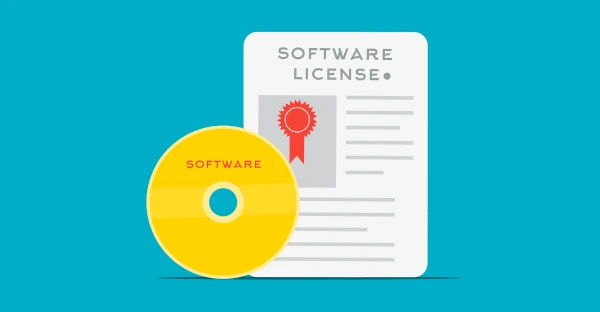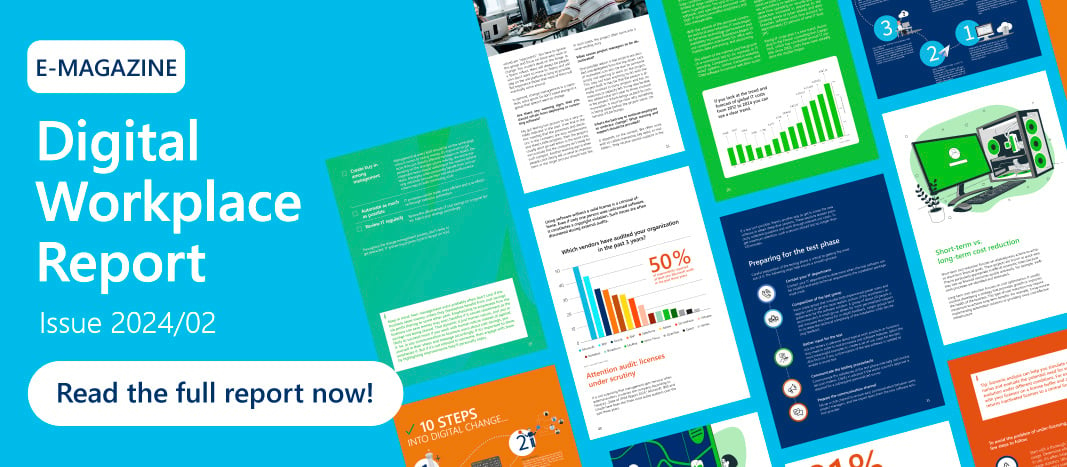Many organizations focus on reducing unused software licenses to avoid unnecessary costs. As Cicero said, “Saving is good income.” However, they often overlook a more serious issue: under-licensing.
A license grants the right to use software. Under-licensing happens when an organization uses software beyond the number of licenses it has purchased. Whether intentional or not, under-licensing exposes organizations to significant risks, including financial loss, reputational damage, and legal liability.
- Copyright and under-licensing
- What to expect when under-licensing
- Causes of under-licensing
- How can you avoid under-licensing?
- What to do when it's too late?
Using software without a valid license is a criminal offense. Even if only one person uses unlicensed software, it constitutes a copyright violation. Such issues are often discovered during external audits.
Which vendors have audited your organization in the past 3 years?

50% of respondents reported at least one Microsoft audit in the past three years
Attention audit: licenses under scrutiny
It is not surprising that management gets nervous when external auditors scrutinize the company. According to Flexera‘s „State of ITAM Report 2024,“ Microsoft, IBM and Oracle have been the three most active auditors over the past three years.
Auditing firms are often hired and use specialized software to analyze whether sufficient software licenses are in place. They often work on a commission basis, so there is certainly an interest in identifying discrepancies. But does one have to accept such an audit? Check your contracts: when contracts are signed, it is often agreed that the licensee grants the licensor the right to audit.
Copyright and under-licensing
Copyright law grants the author the exclusive right to reproduce, distribute, create derivative works from, publicly perform, and display the work. When the author grants these rights to another party for limited use, it’s called a license agreement. The license agreement may contain various terms and restrictions, such as payment of royalties, duration of the license, geographic restrictions, usage options, and other important provisions governing the rights and obligations of the parties. Software is considered the intellectual property of the software manufacturer and is therefore subject to copyright.
Using unlicensed or under-licensed software violates the software owner’s copyright. In the United States, criminal copyright infringement is addressed under the U.S. Code (Copyright Law). The penalties under Title 18 U.S.C. § 2319 “include imprisonment of up to 5 years for first-time offenders or fines, depending on the severity of the violation and whether the infringement was for commercial gain or personal use.” It’s important to note that the exact consequences may vary depending on the circumstances of each case. It’s advisable to seek legal advice on intellectual property licensing issues.
What to expect when under-licensing
The most serious problem with under-licensing is copyright infringement. In the worst case, you could face high fines and even imprisonment. Even if the licensor doesn’t take legal action, you can expect to pay extra compensation.
Royalties for using copyrighted material can vary greatly depending on the number and duration of uses. In addition, there are associated legal costs in the form of court and attorney fees.
Compensatory damages
The licensor can calculate their actual damages and demand compensation. However, calculating actual damages due to license infringements is rarely possible in practice. It’s therefore rather unusual to choose this method of calculation.
Alternatively, the licensor can claim damages by license analogy. In this case, the licensee must pay the licensor the amount of money that a legally acquired license would’ve cost. This is the usual method and is relatively easy to enforce in court. The licensor can easily estimate the value of the licenses that should have been paid. Courts normally enforce an estimate in favor of the licensor.
Business interruption
The licensor can claim injunctive relief. Injunctive relief doesn’t grant a monetary claim, but it does force the licensee to stop using the software in question. The injunction is usually enforced by a temporary restraining order. This means that the licensee doesn’t have time to find a workaround.
Prosecution
Like any copyright infringement, under-licensing software is always a criminal offense, in the worst case punishable by a prison sentence. In practice, however, prosecution is often negligible.
The crime is only prosecuted upon request, i.e. the licensor must initiate criminal proceedings. Also, the public prosecutor’s office as the competent authority has – at least in its own opinion – more important things to do than to prosecute copyright infringements.
Fines
While a company can’t be imprisoned, it can be fined, particularly when it fails in its supervisory responsibilities. In some cases, fines as large as one billion euros have been imposed, though such extreme penalties are rare. Fines in the five- to six-figure range, however, are far more common.
Public shaming
There are also indirect effects that aren’t primarily financial. The licensor can demand that the under-licensing be made public. This “naming and shaming” is intended to improve compliance, because it means an enormous loss of reputation for the licensee. In the worst case, you may lose customers or investors due to losing their trust.

Causes of under-licensing
There are many reasons for under-licensing. It’s usually not a deliberate attempt to save money by reducing the number of licenses.
- Without efficient mechanisms for managing license agreements, licenses can expire unnoticed or go unrenewed. This is especially true for larger organizations that have many licenses for different software. Or when licenses are transferred between departments and subsidiaries.
- Depending on the software, licensing models can be very complex. In practice, there are two main licensing models: named licenses and concurrent licenses. Especially for smaller companies or those without the necessary resources, it can be difficult to understand the exact scope of licensing requirements. This can lead to purchasing fewer licenses than needed. A lack of monitoring can also lead to a loss of visibility over existing or required licenses.
- Organizations may miscalculate their software license needs. This is especially true when the company grows faster than expected, when business processes change, or when other factors cause demand to grow faster than expected. When licenses are purchased in advance, they’re often insufficient
Named license: often less expensive, one license per user.
Concurrent license: usually more expensive, multiple users can share a license.
How can you avoid under-licensing?
Intelligent license management as part of software asset management helps you keep track of the licenses you need and the licenses you use, so you can avoid under-licensing. It’s not only about keeping an eye on costs, but also about complying with legal and contractual requirements.
Who is responsible for license management within an organization varies from case to case. Defining the roles and responsibilities of the various departments and appointing the appropriate people is critical to successful license management.
License managers play a central role. Depending on the size of the company and its organizational structure, they may be involved in day-to-day operations or strategic planning and coordination of license management. Regardless of their focus, license managers are the primary point of contact for all licenserelated issues and should work closely with the appropriate business units. This is the only way to ensure that software licensing requirements and employee needs are fully addressed. With the increasing use of cloud and subscription solutions, it is important to work closely with FinOps teams to ensure that software licensing is included in the cost planning and deployment of the cloud.
Note: Browser-based applications, which are increasingly important, are a special case when it comes to licensing. Often other conditions apply and no licenses are required.
Tip: Scenario analysis can help you simulate different deployment scenarios and evaluate the potential need for software licenses and their evolution under different conditions. For extra flexibility, you can agree with your licensor on a license buffer and a license activation check that returns inactivated licenses to a central license pool.
To avoid the problem of under-licensing, there are a few steps to follow.
Start with a thorough inventory. Review all existing licenses and their usage. Determine what applications are licensed and what versions are in use. It’s often helpful to catalog the software. Also look at software usage statistics. What modules and extensions are people using? What features aren’t used? This is often a cost trap because demand doesn’t match licenses.
Implement a centralized database or software asset management system (SAM) to track all purchased licenses. This makes it easy to track license information such as expiration date, terms of use, and license usage. But that‘s not all. In Flexera‘s „State of ITAM Report 2024,“ 91% of IT professionals surveyed said they have realized savings from a SAM program by reusing licenses instead of buying new.
Periodically review your license agreements to ensure they meet current needs. Identify potential under-licensing and promptly adjust your licensing accordingly. Consider future developments that may change your licensing requirements.
Educate employees on the importance of license management and compliance. Make them aware of the impact of under-licensing and the risk of legal ramifications for the company.
Conduct periodic compliance audits to ensure that your organization is complying with the terms of the license. These audits can be internal or external, depending on your company‘s needs and risks.
91% of IT professionals surveyed said they have realized savings from a SAM program by reusing licenses instead of buying new.
What to do when it’s too late?
Suppose you discover that there is indeed a case of under-licensing in your company. What should you do?
The first step is to assess the extent of under-licensing. What’s the scope? How many licenses are involved?
If you discover the under-licensing on your own contact the vendor immediately. By being proactive, you’re most likely to avoid legal action by the vendor, purchase the additional licenses you need, and make additional payments for missing licenses without penalty. The more transparent you are with a licensor about the problem, the less likely they’ll take legal action. If necessary, seek legal advice to ensure that all necessary steps are taken to resolve the under-licensing issue as quickly and easily as possible.
It can be problematic if the under-licensing isn’t discovered by you, but by an external software audit. In that case, you’ll have to prove that you didn’t intentionally misappropriate licenses from the licensor.
Many experts agree that the increasing trend toward cloud-based software products will lead to fewer problems with under-licensing. Others argue that the move to subscriptions and the cloud is creating the „transparent customer“ because usage is always logged and therefore very transparent, which is tantamount to a continuous audit.
You May Also Like
Related articles

Smart license management that reduces costs: now it counts

Smart license management: How Brose optimizes costs


